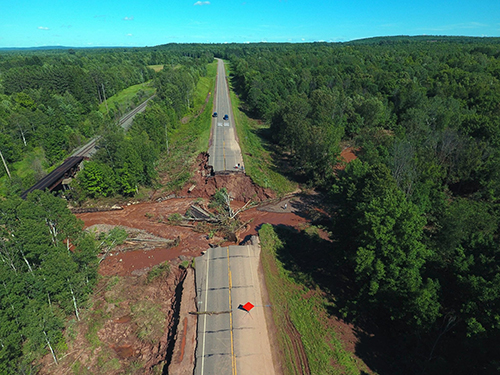Aquatic Connectivity
Connectivity of aquatic habitat is important to Great Lakes fishery managers because natural stream characteristics are important elements of habitat for fish production. When streams are fragmented, restricted movement of fish is just one impact. Reduced connectivity also affects water flow; alters the stream’s capacity to  acquire, move, and deposit soil and sediments, plants, and invertebrates; and changes the stream’s ability to modify the stream-bed and channel through erosion. Improving connectivity between the Great Lakes and their tributary streams supports increased production of desired fish populations ranging from salmon and trout to walleye to lake sturgeon.
acquire, move, and deposit soil and sediments, plants, and invertebrates; and changes the stream’s ability to modify the stream-bed and channel through erosion. Improving connectivity between the Great Lakes and their tributary streams supports increased production of desired fish populations ranging from salmon and trout to walleye to lake sturgeon.
Fragmentation in the Great Lakes basin is largely caused by structures that benefit humans—dams and road-stream crossings. However, this separation can bring important ecological benefits: assisting with control of sea lamprey and other invasive species, protecting threatened and endangered species from predators and competitors, and preventing contaminant spread. The Great Lakes Fishery Commission sits at the intersection of these two views of connectivity because of its mandate to control sea lamprey and its role to facilitate cooperative fishery management, which seeks increased production of desired fish species through improved connectivity. As a result, the commission is leading innovative organizational and research approaches to improving connectivity while also effectively controlling sea lamprey.
_SMALL.jpg)
Reconnecting aquatic habitats by removing dams or installing fish-friendly stream crossings occurs at the local level. These efforts could benefit from improved coordination, collaboration, and awareness of larger-scale impacts, coupled with clearly stated objectives aligned with regional goals. Council of Great Lakes Fishery Agencies’ Connectivity Tradeoffs Committee is one pathway to collaboratively set regional connectivity goals and objectives, and join efforts to achieve those common goals. The commission and others are identifying and prioritizing lowermost barriers that are important to continued control of sea lamprey, and are are developing visualization and decision support tools that assist managers with prioritizing where to focus protection and restoration efforts. Additionally, the commission has embarked on an innovative bi-directional selective fish passage project, called FishPass, in the Boardman River near Traverse City, Michigan. This project is exploring technologies that re-establish aquatic connectivity for native species restoration and enhancement of desirable fishes while simultaneously blocking or removing aquatic invasive species.
Ashland County flooding photo courtesy of University of Wisconsin-Extension

